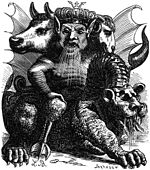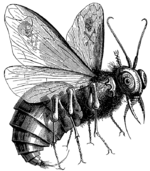Dictionnaire Infernal

The Dictionnaire Infernal (English: "Infernal Dictionary") is a book on
History
Dictionnaire Infernal was first published in 1818 and then divided into two volumes, with six reprints—and many changes—between 1818 and 1863. This book attempts to provide an account of all the knowledge concerning superstitions and demonology.
A review in 1822 read:
Anecdotes of the nineteenth century or stories, recent anecdotes, features and little known words, singular adventures, various quotations, compilations and curious pieces, to be used for the history of the customs and the mind of the century in which we live, compared with centuries past.
The cover page for the 1826 edition reads:
Infernal Dictionary, or, a Universal Library on the beings, characters, books, deeds, and causes which pertain to the manifestations and magic of trafficking with Hell; divinations, occult sciences, grimoires, marvels, errors, prejudices, traditions, folktales, the various superstitions, and generally all manner of marvellous, surprising, mysterious, and supernatural beliefs.
Influenced by Voltaire, Collin de Plancy initially did not believe in superstition. For example, the book reassures its contemporaries as to the torments of Hell: "To deny that there are sorrows and rewards after death is to deny the existence of God; since God exists, it must be necessarily so. But only God could know the punishments meted out to the guilty, or the place that holds them. All the catalogues made herebefore are only the fruit of a more or less disordered imagination. Theologians should leave to the poets the depiction of Hell, and not themselves seek to frighten minds with hideous paintings and appalling books" (p. 164).[3]
The skepticism of Collin de Plancy increasingly subsided over time. By the end of 1830 he was an enthusiastic
Many articles written in the Dictionnaire Infernal illustrate the author's vacillation between
List of demons
-
Bael
-
Beleth
-
Flaga
- Abaddon/Apollyon
- Abigor also known as Eligos
- Abraxas/Abracas
- Adramelech
- Aguares
- Alastor
- Alocer
- Amduscias
- Amon
- Andras
- Asmodeus
- Astaroth
- Azazel
- Bael
- Balan
- Barbatos
- Behemoth
- Beleth
- Belphegor
- Belzebuth
- Berith
- Bhairava/Beyrevra
- Buer
- Caacrinolaas
- Cali
- Caym
- Cerbere
- Deimos/Deumus
- Eurynome
- Flaga
- Flavros
- Forcas
- Furfur
- Ganga/Gramma
- Garuda
- Guayota
- Gomory
- Haborym
- Ipes
- Lamia
- Lechies
- Leonard
- Lucifer
- Malphas
- Mammon
- Marchosias
- Melchom
- Moloch
- Nickar
- Nybbas
- Orobas
- Paimon
- Picollus
- Pruflas/Busas
- Rahovart
- Ribesal
- Ronwe
- Scox
- Stolas
- Tap
- Torngarsuk
- Ukobach
- Volac
- Wall
- Xaphan
- Yan-gant-y-tan
- Zaebos
Early editions
Contents of the Dictionaire Infernal varied across different early imprints:
- 1818: first edition
- 1825: second edition
- 1826: reprint of second edition
- 1844: third edition
- 1845: fourth edition
- 1853: fifth edition
- 1863: sixth edition, illustrated by Louis le Breton
See also
References
- ISBN 978-0-7387-2745-5.
- ^ Dictionnaire infernal: répertoire universel des êtres, des personnages, des livres, des faits et des choses qui tiennent aux esprits ... H. Plon. 1863. p. 11.
- ^ a b "XLII/KWS 37/Dictionnaire infernal". Quarante-deux.org. 2012-04-25. Archived from the original on 2012-02-05. Retrieved 2012-06-19.
- ^ "Dictionnaire infernal – Chroniques Livre". La Horde Noire. Archived from the original on 2011-02-19. Retrieved 2012-06-19.
- ^ "Exorcisme catholique". Atheisme.free.fr. Retrieved 2012-06-19.
- ISBN 978-0997074512.
External links
- Dictionnaire infernal, ou, Recherches et anecdotes, sur les démons (1818) at Google Books, PDF download available
- Dictionnaire infernal, ou Recherches et anecdotes sur les démons, 1844 at Google Books, PDF download available
- Dictionnaire des sciences occultes: ou, Répertoire universel des êtres, des, 1848 at the Internet Archive, PDF download available
- Dictionnaire infernal: ou Répertoire universel des êtres, des personnages, 1853 582 pages – at at the Internet Archive PDF; download available
- Dictionnaire infernal: ou Répertoire universel des êtres, des personnages, 1863 PDF download available.
- Deliriums Realm – Dictionnaire Infernal
- Boards of the edition of 1826 on the site of the electronic library of Lisieux








